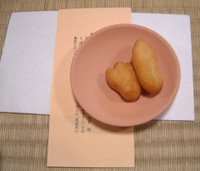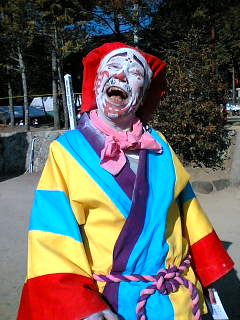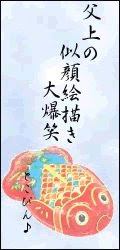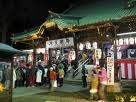[ . BACK to WORLDKIGO TOP . ]:::::::::::::::::::::::::::::::::::::::::::::::::::::::::::::::::::::::::::::::::::::::::::::::::::
Introducing First Court Rituals of the New Year
***** Location: Japan
***** Season: New Year
***** Category: Observances *****************************
Explanation
quoteWelcome to the Imperial Household Agency
HomepageThis homepage presents an introduction to the official duties and various public activities of Their Majesties the Emperor and Empress, and other members of the Imperial Family, carried out both at the Imperial Palace and outside, the latter including their official visits within Japan and their fostering of friendly relations with foreign countries.
We hope that this homepage will provide a useful reference for a large number of people who may wish to deepen their knowledge about the activities and traditions of the Imperial Family.
Kunaichoo 宮内庁ホームページ :::::::::::::::::::::::::::::::::::::::::::::::::::::::::::::::::::::::::::::::::::::::::::::::::::::
Chooga 朝賀 First Morning Audience..... choohai 朝拝
..... haiga 拝賀
..... sanga 参賀
..... 新年祝賀の儀 New Year Audience
Their Majesties' New Year Reception 
At the Imperial Palace each year on 1 January, Their Majesties the Emperor and Empress receive New Year greetings from His Imperial Highness the Crown Prince and the rest of the Imperial Family; the Speaker and Vice-Speaker of the House of Representatives and the President and Vice-President of the House of Councillors; Diet members; the Prime Minister; Ministers of State; the Chief Justice and Justices of the Supreme Court; other government officials with Imperial attestation (Ninshokan); Administrative Vice-Ministers of Ministries and Agencies and other leading figures of legislative, executive and judicial organs; prefectural governors and chairpersons of prefectural assemblies; and heads of diplomatic missions to Japan and their spouses. This ceremony is considered a state event.
http://www.kunaicho.go.jp/e04/ed04-01.html
People's Visit to the Palace for the New Year Greeting新年一般参賀 shinnen ippan sanga

At the Imperial Palace each year on 2 January, Their Majesties the Emperor and Empress receive New Year Greetings from the people.
Their Majesties the Emperor and Empress appear with the rest of the Imperial Family on the Imperial Palace veranda several times. On this occasion, His Majesty the Emperor addresses the people. The people enter from the main gate of the Palace and offer their good wishes in the East Plaza of the Imperial Palace.
Visits by the general public to offer congratulations in the New Year Celebration at the Imperial Palace began on 1 January 1948.
At the time, the celebration lasted from noon until 4:00 p.m. Visitors entered from the Main Gate and left from the Sakashita-mon Gate after signing the visitors' books installed near the iron bridge inside the Main Gate. Although none of the members of the Imperial Family appeared before the visitors, Emperor Showa did observe the scene of the visits from the roof of the Imperial Household Agency building.
On 1 January 1951, Emperor Showa and Empress Kojun appeared before visitors for the first time, on the balcony above the central entrance to the Imperial Household Agency. From 1953, the day of the greeting was moved to 2 January due to event schedule.
Later, these visits by the general public were temporarily suspended due to construction of the Imperial Palace. Since 1969, this ceremony has been held at the present Imperial Palace.
http://www.kunaicho.go.jp/e04/ed04-01.html 癸未絵馬さげてゆく朝賀かなmizunoto hitsuji ema sagete yuku chooga kana
弓人
http://www.maki-taro.net/haiku/cgi-bin/kakolog/85.html
:::::::::::::::::::::::::::::::::::::::::::::::::::::::::::::::::::::::::::::::::::::::::::::::::::::
Daijin ke no daikyoo 大臣家大饗 (だいじんけのだいきょう)
First banquet of the Ministers..... omoya no daikyoo 母屋の大饗 (もやのだいきょう)
banquet in the main house
Since the Heian period.
 source : d.hatena.ne.jp/K-sako
source : d.hatena.ne.jp/K-sako The ministers greet visitors in their own homes (omoya) and have a feast. The most important visitor is called 尊者 sonsha.
On this day an envoy from the imprial court, 蘇甘栗使 soamaguri no tsukai, is also welcomed.
He brought an old version of butter, 牛酪 gyuuraku, and dried chestnuts kachiguri 搗栗.
:::::::::::::::::::::::::::::::::::::::::::::::::::::::::::::::::::::::::::::::::::::::::::::::::::::
Ganjitsu no Sechi-E 元日節会 Audience and Reception of Politicians
Introduced after the Meiji Reformation. The Emperor meets with the politicians for a first audience and exchanges a glass of ricewine.
Hare no Gozen 晴の御膳 Official Lunch ReceptionHare no Omono 晴御膳 はれのおもの
..... Gozen no gi 御膳の儀
In the Phoenix Hall of the Imperial Palace. Now it can be held on any of the first three days of the new year.
The menu was composed first in the Heian period and is still served today.
vinegar, ricewine, salt and soy sauce, the four condiments
dumplings, konton こんとん 昆飩 餛飩
round dumplings with minced meat and vegetables, served with broth
noodles, sakubei さくべい 索餅
The oldest form of the noodles, sakubei, produced by adding rice powder to flour, was introduced from China in the eighth century.
"scorpion snack", katsuko かつこ 餲餬, □餬Snacks kneaded with wheat flower, in the shape of a scorpion (蝎 すくもむし sukumomushi).
dumplings with cinnamon, keishin けいしん 桂心
Wheat and medical cinnamon where kneaded into a form of a three-cornered priest hat.
..... Four types of snacks from ancient China:
round dumplings, tsuishi ついし 餓子made from flower, then fried.
"navel cakes" tensei てんせい 黏臍
dumplings with a shape of the human navel. Made from flower, then fried.
crackers, hitsura ひつら,ひちら 饆饠Made from rice flower. Round and flat types of bisquits.
dumplings, danki だんき 団喜, kankidan 歓喜団Made from wheat flower. Today they are still used as offerings in Buddhist rituals.
The above types of snacks were also introduced from China in the Heian period. There are eight famous snack from China (hasshuu no karagashi 八種の唐菓子, 八種唐菓子). This custom of serving them shows the strong influence of the Chinese culture on the aristocracy during the Heian period.
They are mostly made of rice or wheat flower, kneaded into auspicious shapes, filled with minced meat or vegetables and fried for consumption. They were also called "fruit" kudamono 果物.
KU meand KI, tree, "ki no mono" like nuts. These snacks were made from the fruits of trees also.
Another old meaning of KUDAMONO is "fish snacks to be eaten with ricewine".
Snack from the Heian Period http://evagenji.hp.infoseek.co.jp/kudamono1.htm
http://evagenji.hp.infoseek.co.jp/kudamono1.htm
http://www.meikatanbou.com/chi_/chi_w/w_s055.htm http://www2u.biglobe.ne.jp/~heian/kenkyu/gourme/okasi.htm :::::::::::::::::::::::::::::::::::::::::::::::::::::::::::::::::::::::::::::::::::::::::::::::::::::
Hagatame, O-Hagatame (teeth strenghtening) tooth hardening, teeth hardeninghagatame 歯固 歯がため はがため
rice cakes for strengthening the teeth
..... hagatame no mochi 歯固の餅 はがためのもち
Diamond Petal Rice Cakes
..... hishi hanabira mochi, 菱葩餅 ひしはなびらもち
:::::::::::::::::::::::::::::::::::::::::::::::::::::::::::::::::::::::::::::::::::::::::::::::::::::
Hime hajime ひめ始 ひめはじめ 姫始(ひめはじめ)
Beginning of first female activitieshime hajime 飛馬始(ひめはじめ)
hime hajime 姫糊始(ひめはじめ)
hime hajime 火水始(ひめはじめ)"first fire and water"
hime hajime 密事始(ひめはじめ)
written with the character for "
secret" 秘め
is about the first intimate getting together of a good couple.
:::::::::::::::::::::::::::::::::::::::::::::::::::::::::::::::::::::::::::::::::::::::::::::::::::::
In no Hairai 院の拝礼 First Audience for High OfficialsFirst of January. This ceremony started during the Heian period. It was held in the park of the Imperial Palace. Now this audience is held more in private, while the official New Year Reception is held for officials (see above).
人だかり 院の拝礼 目指しけり hito dagari In no Hairai mezashikeri
http://www1.linkclub.or.jp/~bookends/writinglog/575spring.html
.................................................................................
Joi 叙位 (じょい)
official bestowing of a new rank or title January 5 or 6
Conferment of a court rank, from the fifth rank upward.
A written document was handed to the bearer.
:::::::::::::::::::::::::::::::::::::::::::::::::::::::::::::::::::::::::::::::::::::::::::::::::::::
Kijizake (kiji sake) 雉子酒, "pheasant ricewine" kiji shu 雉子酒(きじしゅ)
o kiji おきじ

It was offered to all New Year visitors to the Emperor's palace.
Finely grilled pheasant meat was immersed in a sip of hot ritual sake.
In olden times, only the aristocracy was allowed to eat pheasant meat at rituals.
.................................................................................
 source : www.shiryodo.jp kissho no soo 吉書奏 auspicious writing
source : www.shiryodo.jp kissho no soo 吉書奏 auspicious writingOn day nine of the first lunar month or an auspicious day the emperor wrote auspicious words. They were than looked at from the high ministers to the lower ones.
The words could be something like
諸国の鑰賜いて、不動の倉開かんand were decided by the ritual keepers.
.................................................................................
Komatsu hiki, 小松引 Pulling Pine Seedlings ..... First Day of the Rat (hatsune)
..... greens of the day of the rat, ne no hi gusa 子の日草
and a few more
 Koosho Hajime 講書始 First official lecture
Koosho Hajime 講書始 First official lecture
at the Imperial Court..... hatsu koosho 初講書(はつこうしょ)
In the presence of the emperor and his family.
This kind of official lecture was also held at the Shogun castle.
In its present form it was introduced at the beginning of the Meiji period.
Subjects of the lecture can be literature, society or nature.
:::::::::::::::::::::::::::::::::::::::::::::::::::::::::::::::::::::::::::::::::::::::::::::::::::::
 mai goran 舞御覧 (まいごらん) dance for the emperor
mai goran 舞御覧 (まいごらん) dance for the emperorOn the 17th or 19th of the first lunar month.
In the eastern park of the hall Seiryooden 清涼殿 Seiryoden.
Or in the southern park of the hall Shishinden 紫宸殿.
With musicians on the left and the right, a dance is performed for the emperor.
Up to 120 different dances can be performed.
.................................................................................
matsubayashi 松囃子 (まつばやし)
First official performance of the arts..... 松拍子(まつばやし)
o utaizome 御謡初(おうたいぞめ)

suoonugi, suoo nugi 素襖脱ぎ(すおうぬぎ)
taking off the suoo ceremonial robeOn the third day of the first lunar month.
The first performance of music and dacne. It was performed at the Toshogu at Ueno until the Meiji period and abolished after WW II.
. Matsubayashi and oshagiri お囃子 . :::::::::::::::::::::::::::::::::::::::::::::::::::::::::::::::::::::::::::::::::::::::::::::::::::::
Matsurigoto hajime 政始 beginning of political activities ritual at the imperial court, after the
Misaie, Mi Sai E 御斎会, which isheld from January 8 for seven days, on an auspicious day.
The duties at Ise shrine were also started on this day.
. WKD : Matsurigoto 政 . The importance of a matsuri, a festival for the appeasement of the deities, can also be seen in the word
matsurigoto, a word that originated in the performance of religious festivals by the emperor or regent and soon became identical with "governing" in general.
:::::::::::::::::::::::::::::::::::::::::::::::::::::::::::::::::::::::::::::::::::::::::::::::::::::
mikamaki 御薪 Honorable fire wood ..... mimaki 御薪(みまき)
mikamaki tatematsuru 御薪奉る(みかまぎたてまつる)
offering firewood
January 15
At the imperial palace in Kyoto, firewood was brought by the 100 officials in charge.
It was 7 shaku long and 12 pieces in a bundle. The amount of bundles was determined by the rank of the officials.
Firewood was also offered to important temples and shrines.
mikamagi 御竈木(みかまぎ) "wood for the honorable stove"
. firewood and kigo . .................................................................................
mikusuri o kuuzu 御薬を供ず offering honorable medicine..... toso 屠蘇(とそ)ritual ricewine
byakusan 白散(びゃくさん)
doshoosan, toshoosan 度嶂散(どしょうさん)
kusurigo 薬子(くすりご)"child drinking medicine"
To prolong life, special food was eaten by the emperor in the first three days of the year.
see also
hagatame above.
The honorable medicine came in three offers, swimming in ricewine.
The first sip was taken by a young girl (kusurigo).
一 献に屠蘇
二献に神明白散
(it contains finely chopped 白朮(びゃくじゅつ)・桔梗(ききょう)・細辛(さいしん))
三献に度嶂散
(it contains finely chopped 麻黄、山椒、細辛、防風、桔梗、乾姜、白朮、肉桂)
quoteThe tradition of drinking toso at the New Year began in the Tang Dynasty in China, and was adopted by Japanese aristocrats during the Heian period. The first cup drunk would be made with tososan, and the second and third cups with different varieties called byakusan and toshōsan.
The drinking ceremony finally passed to the general public and doctors would give out tososan. Even today some chemists shops have retained the custom and give tososan away as a free gift at the end of the year.
Nowadays it is typically made from Japanese pepper, asiasari radix, apiaceae, cinnamon, dried ginger, atractylodes Japonica, Chinese bellflower and rhubarb, amongst others
© More in the WIKIPEDIA !. Food as Medicine (yakuzen 薬膳) . :::::::::::::::::::::::::::::::::::::::::::::::::::::::::::::::::::::::::::::::::::::::::::::::::::::
. noriyumi 賭弓 bow shooting contest . ..... noriyumi 賭射(のりゆみ)
keari aruji 還饗(かえりあるじ)
noriyumi no sechi 賭弓の節(せち)
January 18
on the day before was the ceremony of
jarai 射礼 (じゃらい) "respectful shooting"..... inokoshi, i no koshi 射遺 (いのこし)
in the presence of the emperor.

射遺・賭弓 - 年中行事絵巻 scroll with yearly rituals
MORE photos from this scroll:
source : shugakuin.blogzine.jp At the sound of the bell arrows were shot toward the target and each time it hit, a drum was beaten.
The archer with the most hits was then honored.
射遺の肩の力の抜き加減 inokoshi no kata no chikara no nuki kagen
at the shooting ritual
the delicate adjustments
of shoulder tension Sekiguchi Ringo 石口りんご
.................................................................................
shihoohai, shihoo hai 四方拝 ( しほうはい) prayer to the four directionshoshi o tonaeru 星を唱ふ praising the stars
hoshibotoke 星仏 "buddhas for each of the nine stars" 九曜星
for peace on land and sea.
January 1, at 5:30 in the morning
The emperor performs this ritual at the Ise shrine or has to bow in this direction with a prayer for peace and a good harvest for the coming year.

Ritual dance is also performed.
四方拝禁裡の垣ぞ拝まるる
俳句俳話ノート
http://nobu-haiku.cocolog-nifty.com/haiwanoto/鬼瓦まっさらになり四方拝oni-gawara massara ni nari shihoo-hai
demon roof tiles -
becoming cleansed from the
prayer in four directions
Minami
http://earthlanguage.org/poem/0202.htm:::::::::::::::::::::::::::::::::::::::::::::::::::::::::::::::::::::::::::::::::::::::::::::::::::::
Tooka no sechi e 踏歌節会 Sechie Dancing Ritual .... 踏歌の節会
..... tooka 踏歌(とうか)
otoko tooka 男踏歌(おとことうか)dancing of men
onna tooka 女踏歌(おんなとうか) dancing of women
ararebashiri 霰ばしり(あらればしり)"running like hailstones"
kazashi no wata 插頭綿(かざしのわた)cotton flowers for your hair
tooka means rhythmically stepping on the ground while singing and dancing. This customs comes from Tang China. It has then been combined with Japanese forms of dancing as a prayer for a good harvest and been performed at the Imperial Court since the Heian period.
There are different dances for young men and women.
These dances are also performed at some shrines:
Atsuta toka shinji 熱田踏歌神事
at Atsuta shrine, NagoyaJanuary 11
鹿島踏歌祭
Kashima tooka matsuri 鹿島踏歌祭
at Kashima ShrineHitachi no kuni, Chiba
Sumiyoshi tooka sechi-e 住吉踏歌節会
at Sumiyoshi shrine . . . . . 福餅神事
January 4
Tooka Sechi-e and the Genji Monogatari
 source : ogasawara
source : ogasawara It has been merged with the Japanese
Utagaki 歌垣(うたがき).
It used to be performed on the day before full moon of the first lunar month, to appease the deities of the earth.
Utagaki (歌垣), also read kagai lit. "fence of poems / songs"
courtship song festival, dialog-song
poetic exchange
The word
GAKI - is a change of the original word for kakeru 掛ける :
uta kaki 歌掛き(懸き)- to "throw" a song at an opponent
There were some rules as to how the opponend (of the other sex usually) had to make his/her spontaneous response.
An ancient Japanese ritual peasant gathering. Villagers would sing and dance on the way up to a mountaintop, where singing, dancing, eating, and the reciting of poetry would occur, in celebration of the beginning of spring or autumn. Closely associated with harvest rites, and therefore fertility, these events often also led into much free sexual activity.
Originating prior to the Nara period, the practice of utagaki reached its height during that period (710-794). Many of the songs and poems, as well as accounts of the ritual itself, are recorded in the Man'yōshū and other contemporary documents, making them among the oldest forms of literature in Japan.
© WIKIPEDIA !utagaki meetings are also known in Chin, Indoneia, Bhutan and other countries of Asia as a means for young people to meet and make friends.
It may have turned into
renku linked verse later on.
Some utagaki texts from rural Japan are even in the form 5 7 5.
Liederhecke,
ein gesellschaftliches Ereignis oder Fest im Altertum, zu dem sich die jungen Leute einfanden, um Liebesgedichte auszutauschen.
:::::::::::::::::::::::::::::::::::::::::::::::::::::::::::::::::::::::::::::::::::::::::::::::::::::
Tsuru no hoochoo 鶴の包丁 "cutting a crane"Before the ritual of "mai goran" (see above) on the 17th or 19th of the first lunar month.
A crane was cut by the official "knife master" in an ancient tradition watched by the emperor and the courtiers. The meat was then prepared for a feast, to wish a long life to the emperor and his retainers.
.Hoochoo Doo 庖丁道 the way of the knife . 
at Suwa Shrine 諏訪神社
This ceremony is also done at some shrines to prepare food offerings for the deity.
mai no tsuru no sabaki 舞鶴の捌き
cutting a dancing crane
at Natori shrine, a wild duck is offered
香取神宮 鴨羽盛
source : kawakatu *****************************
Things found on the wayHistory of Food of Japan, by Naomichi Ishige *****************************Related wordsFirst Poetry Meeting at Court (utakai hajime 歌会はじめ)***** WKD: Ceremonies and Festivals of Japan Nihon no Gyooji 日本の行事
Saijiki*****
WASHOKU ... Japanese Food SAIJIKI BACK TOSAIJIKI – NEW YEAR OBSERVANCES ::::::::::::::::::::::::::::::::::::::::::::::::::::::::::::::::::::::::::::::::::::::::::::::::::




















































